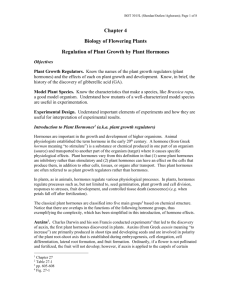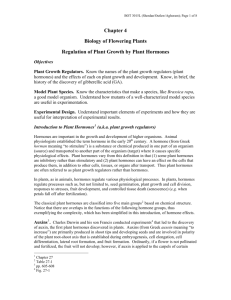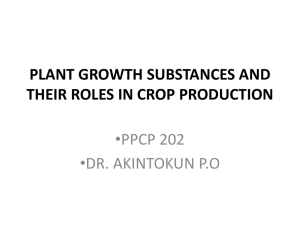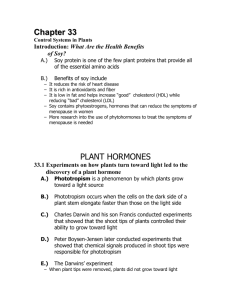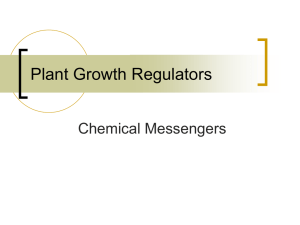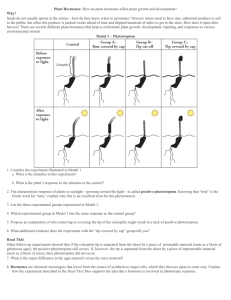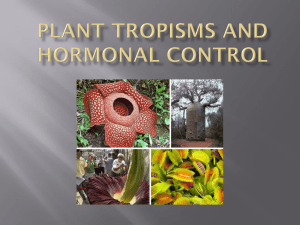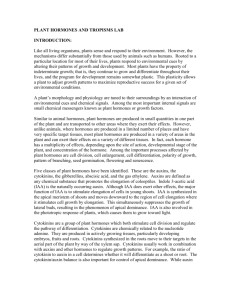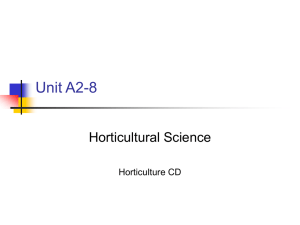Chapter 5 Biology of Flowering Plants Regulation
advertisement
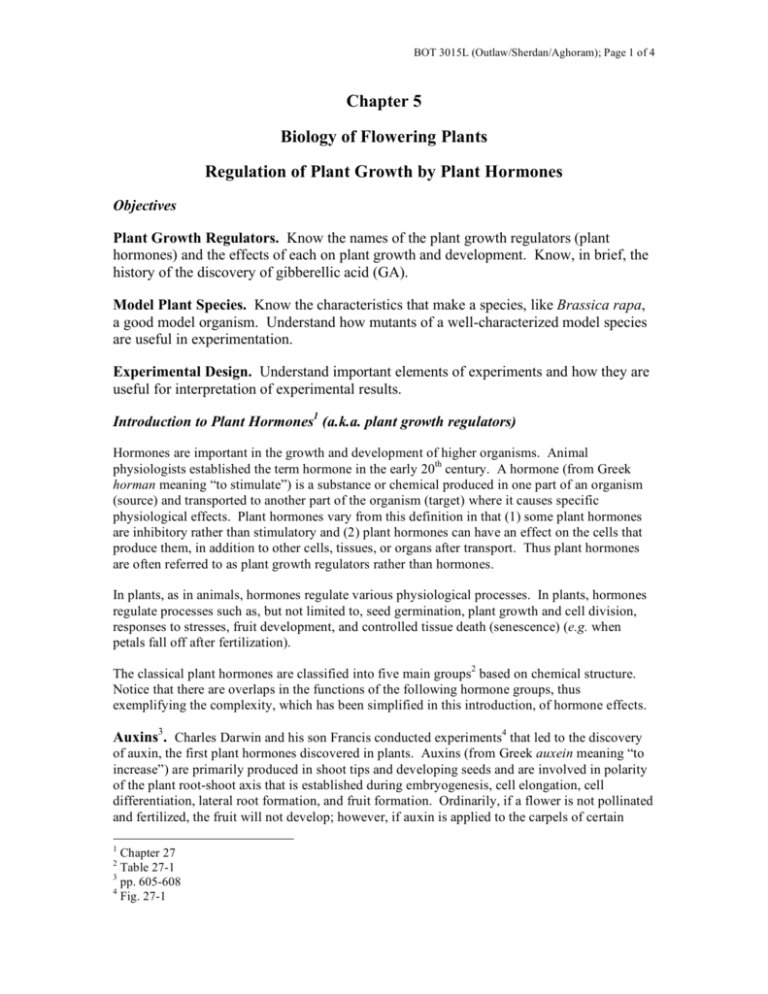
BOT 3015L (Outlaw/Sherdan/Aghoram); Page 1 of 4 Chapter 5 Biology of Flowering Plants Regulation of Plant Growth by Plant Hormones Objectives Plant Growth Regulators. Know the names of the plant growth regulators (plant hormones) and the effects of each on plant growth and development. Know, in brief, the history of the discovery of gibberellic acid (GA). Model Plant Species. Know the characteristics that make a species, like Brassica rapa, a good model organism. Understand how mutants of a well-characterized model species are useful in experimentation. Experimental Design. Understand important elements of experiments and how they are useful for interpretation of experimental results. Introduction to Plant Hormones1 (a.k.a. plant growth regulators) Hormones are important in the growth and development of higher organisms. Animal physiologists established the term hormone in the early 20th century. A hormone (from Greek horman meaning “to stimulate”) is a substance or chemical produced in one part of an organism (source) and transported to another part of the organism (target) where it causes specific physiological effects. Plant hormones vary from this definition in that (1) some plant hormones are inhibitory rather than stimulatory and (2) plant hormones can have an effect on the cells that produce them, in addition to other cells, tissues, or organs after transport. Thus plant hormones are often referred to as plant growth regulators rather than hormones. In plants, as in animals, hormones regulate various physiological processes. In plants, hormones regulate processes such as, but not limited to, seed germination, plant growth and cell division, responses to stresses, fruit development, and controlled tissue death (senescence) (e.g. when petals fall off after fertilization). The classical plant hormones are classified into five main groups2 based on chemical structure. Notice that there are overlaps in the functions of the following hormone groups, thus exemplifying the complexity, which has been simplified in this introduction, of hormone effects. Auxins3. Charles Darwin and his son Francis conducted experiments4 that led to the discovery of auxin, the first plant hormones discovered in plants. Auxins (from Greek auxein meaning “to increase”) are primarily produced in shoot tips and developing seeds and are involved in polarity of the plant root-shoot axis that is established during embryogenesis, cell elongation, cell differentiation, lateral root formation, and fruit formation. Ordinarily, if a flower is not pollinated and fertilized, the fruit will not develop; however, if auxin is applied to the carpels of certain 1 Chapter 27 Table 27-1 3 pp. 605-608 4 Fig. 27-1 2 BOT 3015L (Outlaw/Sherdan/Aghoram); Page 2 of 4 species, fruit can be produced in the absence of fertilization. Fruit development without fertilization is termed parthenocarpy. In large amounts, auxins can be toxic and can inhibit growth. This property of auxins is useful in agriculture; some synthetic auxins are used as weed killers. Cytokinins5. The discovery of cytokinins began in 1941 when Johannes van Overbeek found that coconut milk (liquid endosperm) contains a potent growth factor that greatly accelerates the development of plant embryos, cells, and tissues in test tubes. Subsequently, the growth factor responsible for this growth was isolated from a DNA preparation (see structure Fig. 27-8) and termed kinetin. Kinetin is one of the plant growth regulators that are collectively termed cytokinins. The term cytokinin was established because cytokinins promote cytokinesis, cell division (Recall that mitosis is nuclear division, so technically speaking, formation of two daughter cells requires mitosis and cytokinesis.). Cytokinins also inhibit senescence. Cytokinins are required for plant cell tissue culture, which is important for horticulture, agriculture, and plant biotechnology. Ethylene6. The effects of ethylene on plant growth were first discovered in the 1800s when defoliation of trees along streets was observed around leaks in gas-burning street lamps. Ethylene, a gaseous hyrocarbon, was identified to be the compound in the lamps that caused the defoliation. Ethylene, in most plant species, has an inhibitory effect on cell expansion and growth, promotes senescence, and promotes abscission (shedding of organs such as leaves or floral parts). Ethylene promotes fruit ripening and is commercially useful for this purpose. In addition, ethylene is commercially used to cause leaf abscision (e.g. of cotton before picking), to promote senescence (e.g. of tobacco to speed “curing” before drying), and to promote flowering. Abscisic Acid (ABA)7. Frederick Addicott and associates disovered abscisic acid while studying compounds responsible for abscission of fruits of cotton. At about the same time however, two other groups of scientists discovered the same compound. One group, led by Philip Wareing, was studying bud dormancy in woody plants; the other group, led by van Steveninck, was studying abscission of flowers and fruits from lupine. Despite the name abscisic acid, abscission is more often associated with the presence of ethylene; whereas, ABA is primarily involved in response to stress. ABA is produced during early seed development in most plant species and is responsible for preventing premature germination and ABA levels in seeds decline under conditions that induce germination. ABA is also important in the responses by plants to root stress. When roots experience stresses (such as drought, freezing, or high salt) they produce ABA, which is transported through the xylem to the leaves. Evaporation of water through stomata from leaves helps cool leaves and, most importantly, creates the force necessary to pull water and dissolved nutrients and hormones up from the roots through the xylem to the leaves where photosynthesis takes place. Stomata are regulated by a pair of highly specialized cells, guard cells, that surround the pore. Guard cells respond to ABA, produced by roots under stress conditions, by causing the stomata to close, thus preventing excess water loss. The response by guard cells to ABA is a primary area of research in Dr. Outlaw’s laboratory at FSU. Gibberellins (GA, gibberellic acid)8. The discovery of gibberellins began when Japanese scientists were studying a diseased called “foolish seedling disease” in rice. Plants with this disease grow rapidly, are pale and spindly, and tend to fall over. The disease is caused by a 5 pp. 608-611 pp. 611-612 7 pp. 612-613 8 pp. 613-615 6 BOT 3015L (Outlaw/Sherdan/Aghoram); Page 3 of 4 substance produced by the fungus Gibberella fujikuroi which is parasitic on the seedlings. The substance that causes the symptoms was isolated from bean seeds and termed gibberellin. Gibberellins are important in breaking seed dormancy (contrast to ABA), inducing flowering, stimulating pollen tube formation, and stimulating fruit development. Like auxins, gibberellins can induce parthenocarpic fruits. Application of gibberellin during fruit formation is useful commercially for the production of fruits, such as grapes. Gibberellins also stimulate cell division and elongation, thus explaining the symptoms of the “foolish seedling disease.” Gibberellins have been identified in many species (and are believed to be present in all plant species) of plants at various amounts in all parts of plants. There are over 125 gibberellins that vary in structure and activity; however GA3 is the most thoroughly studied. Understanding the Plant Growth Regulator, GA, through Experimentation9 The question. You are now going to design an experiment and form a hypothesis to answer the question “What are the effects of GA on the growth of Brassica rapa?” Brassica rapa is an agronomically important species that is in the same family as cabbage, broccoli, turnip, mustard, cauliflower, and other familiar vegetables. About one-third of the vegetable oil worldwide is produced by Brassica rapa. Generically, the product is rapeseed oil, but special strains produce a higher quality oil, canola (which is a contraction of Canadian oil low acid). Experiment Design. As a group, design an experiment to answer the question (see Materials below). Write and, if you find it helpful to demonstrate, draw your design in your notebooks. Details (how much? how many? how often? where? how? when?) are important. As a general guideline, GA treatments should be minimally once every other day for 10 days. Include in your design what you plan to measure and observe, i.e. what data you will collect. Remember to include elements of good experimentation, such as controls and repeats for statistical analysis. Due to time constraints, these experiments will continue for three weeks and, in this time, plants may not flower or produce fruit. Materials. The following materials are available for your experiment: • Brassica rapa seeds Paul Williams and his colleagues at the University of Wisconsin have worked for years on the genetics of the Brassicaceae family of plants. Because they are unable to obtain crosses between some species, directly transferring a trait from one vegetable in this family to another is not always possible. However, they are able to transfer the trait to an intermediate plant, one that can be crossed with both donor and recipient. Obviously, time is crucial in science and agriculture, so Williams developed a special strain of B. rapa (the intermediate) that can be grown from seed to seed in a very short period of time and consumes few resources, making it a good model species. Like most excellent research scientists, Paul has been enthusiastic about passing his knowledge to students. To make a long story short, the National Science Foundation and many dedicated people have developed hands-on laboratory exercises that have extended the utility of this plant from the research bench to elementary school. FSU adopted this so-called Fast Plant in 1992. • 9 Rosette (mutant) Brassica rapa seeds Refer to Chapter 1 of the lab manual for tips on “Doing Good Science” BOT 3015L (Outlaw/Sherdan/Aghoram); Page 4 of 4 These mutants produce less GA, which results in a dwarfed phenotype. • Culture materials for planting and growing B. rapa seeds • Solutions containing either 0, 3, or 39 µM GA. If your experiment design requires other materials, check with your instructor to determine availability. Hypothesis. Examine your experimental design and predict what you think will happen. Again, write and, if helpful, draw your predictions in your lab notebook. Procedure and Data Collection. Write in your notebook a step-by-step procedure. Include the detail required for a peer to replicate your work independently. After, the procedure is written in your notebook, execute the procedure as a group. If, as you are executing the procedure, there are any additions or modifications, amend your notebook. Plan to keep a table of data and observations maintained by the entire group with the plants and to keep a record of all data that you as a member of the group collect in your lab notebook. Because this is a group activity, be sure to organize well and commit yourself to your responsibilities. Failure to carefully, ethically, and responsibly conduct the experiment will result in complete loss of credit for this portion of the lab. All members of the group must have equal responsibility during the experiment. Participation points are part of the grade. Remember to uphold the Academic Honor Policy.

